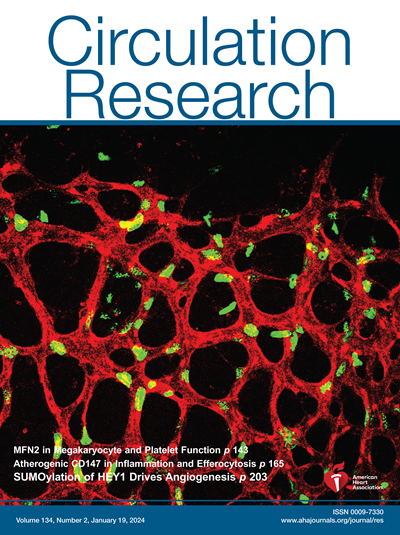Heart Has Intrinsic Ketogenic Capacity that Mediates NAD+ Therapy in HFpEF.
IF 16.5
1区 医学
Q1 CARDIAC & CARDIOVASCULAR SYSTEMS
引用次数: 0
Abstract
BACKGROUND Heart failure with preserved ejection fraction (HFpEF) has overtaken heart failure with reduced ejection fraction as the leading type of heart failure globally and is marked by high morbidity and mortality rates, yet with only a single approved pharmacotherapy: SGLT2i (sodium-glucose co-transporter 2 inhibitor). A prevailing theory for the mechanism underlying SGLT2i is nutrient deprivation signaling, of which ketogenesis is a hallmark. However, it is unclear whether the canonical ketogenic enzyme, HMGCS2 (3-hydroxy-3-methylglutaryl-coenzyme A synthase 2), plays any cardiac role in HFpEF pathogenesis or therapeutic response. METHODS We used human myocardium, human HFpEF and heart failure with reduced ejection fraction transcardiac blood sampling, an established murine model of HFpEF, ex vivo Langendorff perfusion, stable isotope tracing in isolated cardiomyocytes, targeted metabolomics, proteomics, lipidomics, and a novel cardiomyocyte-specific conditional HMGCS2-deficient model that we generated. RESULTS We demonstrate, for the first time, the intrinsic capacity of the human heart to produce ketones via HMGCS2. We found that increased acetylation of HMGCS2 led to a decrease in the enzyme's specific activity. However, this was overcome by an increase in the steady-state levels of protein. Oxidized form of nicotinamide adenine dinucleotide repletion restored HMGCS2 function via deacetylation, increased fatty acid oxidation, and rescued cardiac function in HFpEF. Critically, using a conditional, cardiomyocyte-specific HMGCS2 knockdown murine model, we revealed that the oxidized form of nicotinamide adenine dinucleotide is unable to rescue HFpEF in the absence of cardiomyocyte HMGCS2. CONCLUSIONS The canonical ketogenic enzyme, HMGCS2, mediates the therapeutic effects of the oxidized form of nicotinamide adenine dinucleotide repletion in HFpEF by restoring normal lipid metabolism and mitochondrial function.心脏具有内在生酮能力,可促进 NAD+ 治疗高房颤患者。
背景:保留射血分数的心力衰竭(HFpEF)已超过射血分数降低的心力衰竭,成为全球范围内最主要的心力衰竭类型,其特点是高发病率和死亡率,但只有一种批准的药物治疗:SGLT2i(钠-葡萄糖共转运蛋白2抑制剂)。关于SGLT2i发病机制的主流理论是营养剥夺信号,其中生酮是一个标志。然而,目前尚不清楚典型的生酮酶HMGCS2(3-羟基-3-甲基戊二酰辅酶A合成酶2)是否在HFpEF发病机制或治疗反应中起心脏作用。方法采用人心肌、人HFpEF和心力衰竭伴射血分数降低经心脏采血、建立小鼠HFpEF模型、离体Langendorff灌注、分离心肌细胞稳定同位素示踪、靶向代谢组学、蛋白质组学、脂质组学以及我们构建的心肌细胞特异性条件hmgcs2缺陷模型。结果我们首次证明了人类心脏通过HMGCS2产生酮的内在能力。我们发现HMGCS2乙酰化的增加导致该酶的比活性降低。然而,这被稳定状态下蛋白质水平的增加所克服。烟酰胺腺嘌呤二核苷酸的氧化形式通过去乙酰化恢复HMGCS2功能,增加脂肪酸氧化,并挽救HFpEF的心功能。关键的是,使用有条件的心肌细胞特异性HMGCS2敲低小鼠模型,我们发现在心肌细胞HMGCS2缺失的情况下,烟酰胺腺嘌呤二核苷酸的氧化形式无法挽救HFpEF。结论典型生酮酶HMGCS2通过恢复正常的脂质代谢和线粒体功能,介导了烟酰胺腺嘌呤二核苷酸氧化形式在HFpEF中的治疗作用。
本文章由计算机程序翻译,如有差异,请以英文原文为准。
求助全文
约1分钟内获得全文
求助全文
来源期刊

Circulation research
医学-外周血管病
CiteScore
29.60
自引率
2.00%
发文量
535
审稿时长
3-6 weeks
期刊介绍:
Circulation Research is a peer-reviewed journal that serves as a forum for the highest quality research in basic cardiovascular biology. The journal publishes studies that utilize state-of-the-art approaches to investigate mechanisms of human disease, as well as translational and clinical research that provide fundamental insights into the basis of disease and the mechanism of therapies.
Circulation Research has a broad audience that includes clinical and academic cardiologists, basic cardiovascular scientists, physiologists, cellular and molecular biologists, and cardiovascular pharmacologists. The journal aims to advance the understanding of cardiovascular biology and disease by disseminating cutting-edge research to these diverse communities.
In terms of indexing, Circulation Research is included in several prominent scientific databases, including BIOSIS, CAB Abstracts, Chemical Abstracts, Current Contents, EMBASE, and MEDLINE. This ensures that the journal's articles are easily discoverable and accessible to researchers in the field.
Overall, Circulation Research is a reputable publication that attracts high-quality research and provides a platform for the dissemination of important findings in basic cardiovascular biology and its translational and clinical applications.
 求助内容:
求助内容: 应助结果提醒方式:
应助结果提醒方式:


